Interdependence of the peroxisome-targeting receptors in Arabidopsis thaliana: PEX7 facilitates PEX5 accumulation and import of PTS1 cargo into peroxisomes
- PMID: 20130089
- PMCID: PMC2847529
- DOI: 10.1091/mbc.e09-08-0672
Interdependence of the peroxisome-targeting receptors in Arabidopsis thaliana: PEX7 facilitates PEX5 accumulation and import of PTS1 cargo into peroxisomes
Abstract
Peroxisomes compartmentalize certain metabolic reactions critical to plant and animal development. The import of proteins from the cytosol into the organelle matrix depends on more than a dozen peroxin (PEX) proteins, with PEX5 and PEX7 serving as receptors that shuttle proteins bearing one of two peroxisome-targeting signals (PTSs) into the organelle. PEX5 is the PTS1 receptor; PEX7 is the PTS2 receptor. In plants and mammals, PEX7 depends on PEX5 binding to deliver PTS2 cargo into the peroxisome. In this study, we characterized a pex7 missense mutation, pex7-2, that disrupts both PEX7 cargo binding and PEX7-PEX5 interactions in yeast, as well as PEX7 protein accumulation in plants. We examined localization of peroxisomally targeted green fluorescent protein derivatives in light-grown pex7 mutants and observed not only the expected defects in PTS2 protein import but also defects in PTS1 import. These PTS1 import defects were accompanied by reduced PEX5 accumulation in light-grown pex7 seedlings. Our data suggest that PEX5 and PTS1 import depend on the PTS2 receptor PEX7 in Arabidopsis and that the environment may influence this dependence. These data advance our understanding of the biogenesis of these essential organelles and provide a possible rationale for the retention of the PTS2 pathway in some organisms.
Figures
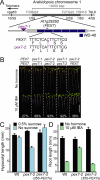
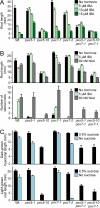

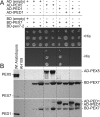
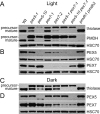
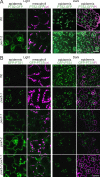
Similar articles
-
The Arabidopsis peroxisomal targeting signal type 2 receptor PEX7 is necessary for peroxisome function and dependent on PEX5.Mol Biol Cell. 2005 Feb;16(2):573-83. doi: 10.1091/mbc.e04-05-0422. Epub 2004 Nov 17. Mol Biol Cell. 2005. PMID: 15548601 Free PMC article.
-
Peroxisomal ubiquitin-protein ligases peroxin2 and peroxin10 have distinct but synergistic roles in matrix protein import and peroxin5 retrotranslocation in Arabidopsis.Plant Physiol. 2014 Nov;166(3):1329-44. doi: 10.1104/pp.114.247148. Epub 2014 Sep 11. Plant Physiol. 2014. PMID: 25214533 Free PMC article.
-
pex5 Mutants that differentially disrupt PTS1 and PTS2 peroxisomal matrix protein import in Arabidopsis.Plant Physiol. 2010 Dec;154(4):1602-15. doi: 10.1104/pp.110.162479. Epub 2010 Oct 25. Plant Physiol. 2010. PMID: 20974890 Free PMC article.
-
Getting a camel through the eye of a needle: the import of folded proteins by peroxisomes.Biol Cell. 2010 Feb 12;102(4):245-63. doi: 10.1042/BC20090159. Biol Cell. 2010. PMID: 20146669 Review.
-
Characterization, prediction and evolution of plant peroxisomal targeting signals type 1 (PTS1s).Biochim Biophys Acta. 2016 May;1863(5):790-803. doi: 10.1016/j.bbamcr.2016.01.001. Epub 2016 Jan 6. Biochim Biophys Acta. 2016. PMID: 26772785 Review.
Cited by
-
Inhibition of BRD4 Promotes Pexophagy by Increasing ROS and ATM Activation.Cells. 2022 Sep 12;11(18):2839. doi: 10.3390/cells11182839. Cells. 2022. PMID: 36139416 Free PMC article.
-
Elevated growth temperature decreases levels of the PEX5 peroxisome-targeting signal receptor and ameliorates defects of Arabidopsis mutants with an impaired PEX4 ubiquitin-conjugating enzyme.BMC Plant Biol. 2015 Sep 16;15:224. doi: 10.1186/s12870-015-0605-3. BMC Plant Biol. 2015. PMID: 26377801 Free PMC article.
-
Role of peroxisomes in the biosynthesis and secretion of β-lactams and other secondary metabolites.J Ind Microbiol Biotechnol. 2012 Mar;39(3):367-82. doi: 10.1007/s10295-011-1063-z. Epub 2011 Dec 11. J Ind Microbiol Biotechnol. 2012. PMID: 22160272 Review.
-
The Roles of β-Oxidation and Cofactor Homeostasis in Peroxisome Distribution and Function in Arabidopsis thaliana.Genetics. 2016 Nov;204(3):1089-1115. doi: 10.1534/genetics.116.193169. Epub 2016 Sep 7. Genetics. 2016. PMID: 27605050 Free PMC article.
-
Matrix proteins are inefficiently imported into Arabidopsis peroxisomes lacking the receptor-docking peroxin PEX14.Plant Mol Biol. 2011 Sep;77(1-2):1-15. doi: 10.1007/s11103-011-9782-0. Epub 2011 May 8. Plant Mol Biol. 2011. PMID: 21553312 Free PMC article.
References
-
- Adham A. R., Zolman B. K., Millius A., Bartel B. Mutations in Arabidopsis acyl-CoA oxidase genes reveal distinct and overlapping roles in β-oxidation. Plant J. 2005;41:859–874. - PubMed
-
- Asamizu E., Nakamura Y., Sato S., Tabata S. A large scale analysis of cDNA in Arabidopsis thaliana: generation of 12,028 non-redundant expressed sequence tags from normalized and size-selected cDNA libraries. DNA Res. 2000;7:175–180. - PubMed
-
- Ausubel F., Brent R., Kingston R. E., Moore D. D., Seidman J. G., Smith J. A., Struhl K. Current Protocols in Molecular Biology. New York: Greene Publishing Associates and Wiley-Interscience; 1999.
-
- Braverman N., Dodt G., Gould S. J., Valle D. An isoform of Pex5p, the human PTS1 receptor, is required for the import of PTS2 proteins into peroxisomes. Hum. Mol. Genet. 1998;7:1195–1205. - PubMed
-
- Brocard C., Kragler F., Simon M. M., Schuster T., Hartig A. The tetratricopeptide repeat-domain of the PAS10 protein of Saccharomyces cerevisiae is essential for binding the peroxisomal targeting signal -SKL. Biochem. Biophys. Res. Commun. 1994;204:1016–1022. - PubMed
Publication types
MeSH terms
Substances
Grants and funding
LinkOut - more resources
Full Text Sources
Molecular Biology Databases

